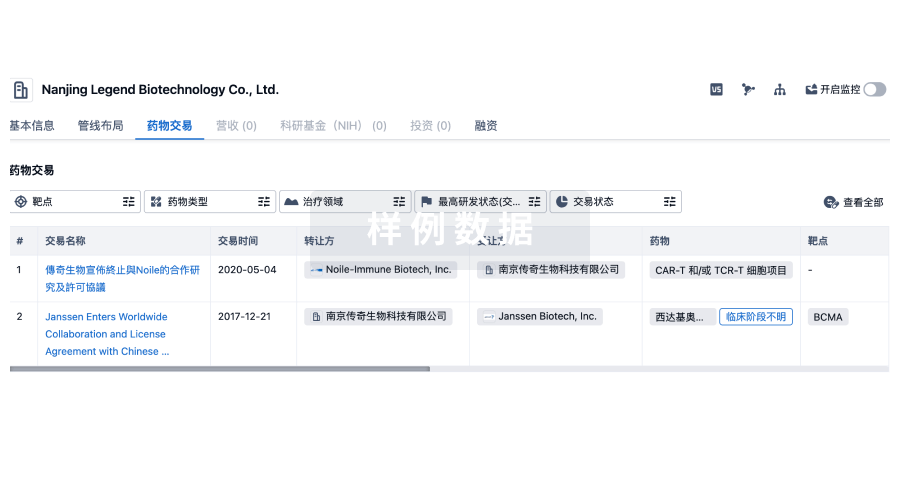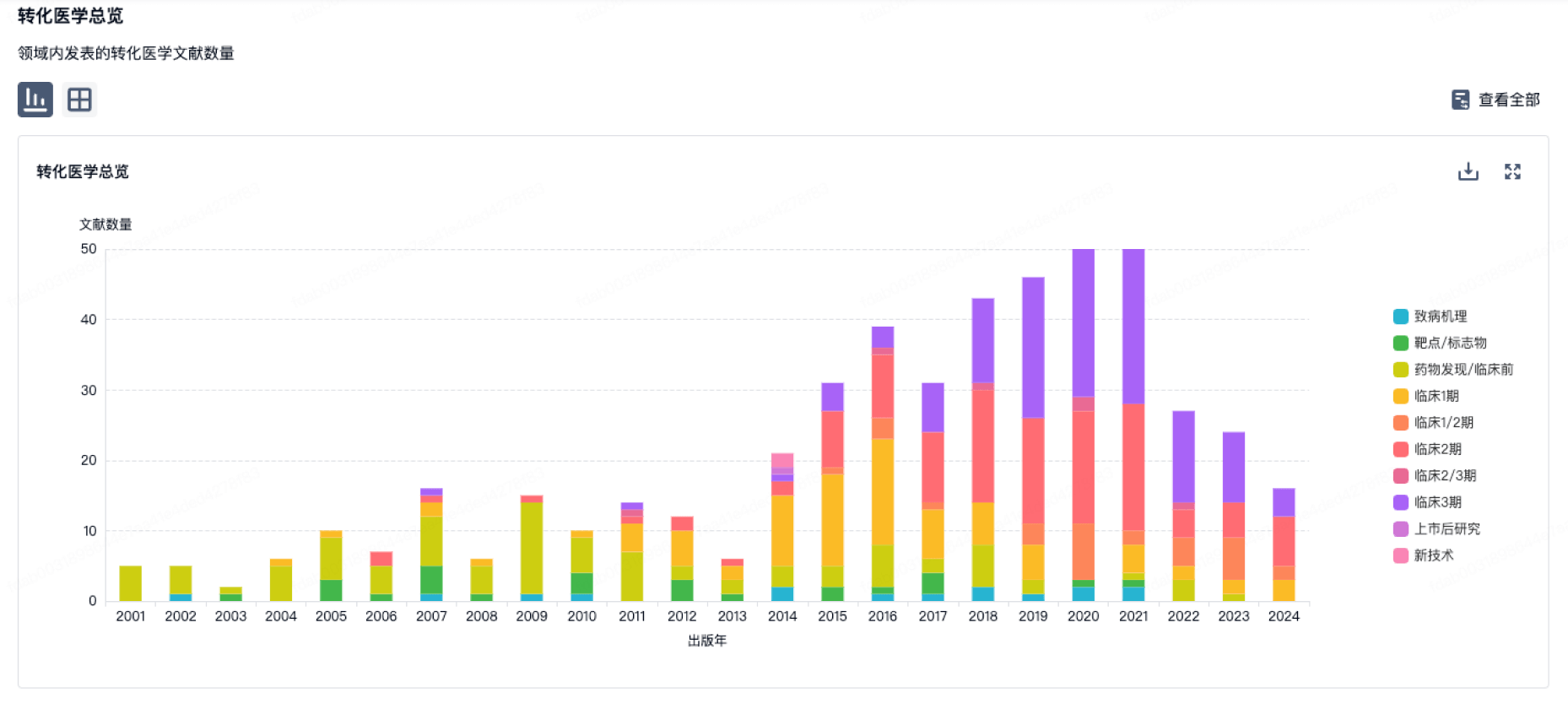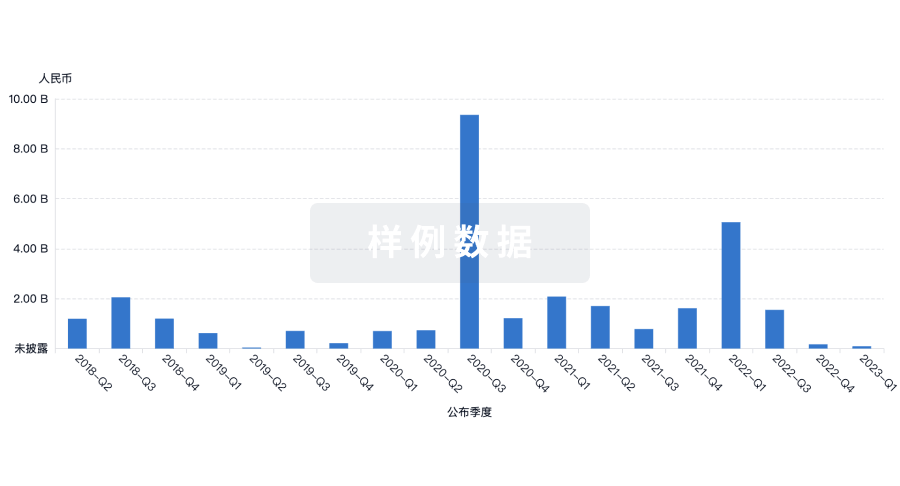预约演示
更新于:2025-05-07

National Institute for Biological Standards & Control
更新于:2025-05-07
概览
标签
遗传病与畸形
血液及淋巴系统疾病
肿瘤
免疫刺激抗体偶联药物(ISAC)
重组凝血因子
疾病领域得分
一眼洞穿机构专注的疾病领域
暂无数据
技术平台
公司药物应用最多的技术
暂无数据
靶点
公司最常开发的靶点
暂无数据
| 排名前五的药物类型 | 数量 |
|---|---|
| 免疫刺激抗体偶联药物(ISAC) | 1 |
| 重组凝血因子 | 1 |
| 排名前五的靶点 | 数量 |
|---|---|
| factor IX(凝血因子IX) | 1 |
| HER2(受体蛋白酪氨酸激酶 erbB-2) | 1 |
关联
2
项与 National Institute for Biological Standards & Control 相关的药物靶点 |
作用机制 HER2拮抗剂 [+1] |
在研适应症 |
非在研适应症- |
最高研发阶段临床前 |
首次获批国家/地区- |
首次获批日期- |
作用机制 factor IX刺激剂 |
在研适应症- |
非在研适应症 |
最高研发阶段临床前 |
首次获批国家/地区- |
首次获批日期- |
3
项与 National Institute for Biological Standards & Control 相关的临床试验NCT00814385
A Randomized, Partially Observer-blind, Single-centre Study to Evaluate Safety and Immunogenicity of MF59-adjuvanted or Non-adjuvanted H5N1 Influenza Vaccines in Adults Primed With Adjuvanted Influenza A/Vietnam/1194/04 (H5N1) Vaccine
This study focuses on pre-pandemic priming of man against H5 influenza with the goal of mounting a robust antibody response to small quantities of vaccine either before or during an H5 pandemic.
开始日期2008-11-01 |
申办/合作机构 |
NCT00625677
A Phase IV, Randomized Study to Evaluate the Immune Response of UK Infants Receiving DTaP/Hib/IPV, Meningococcal C Conjugate and Pneumococcal Conjugate Vaccines, Antibody Persistence and Responses to Booster Doses in the Second Year of Life
The purpose of this study is:
To assess whether there are differences in antibody persistence eight months post primary (pre-booster) or in responses to the booster with regard to the Meningococcal C Conjugate (MCC) vaccine given in infancy.
To examine levels of diphtheria and tetanus antibody pre- and post-booster, with regard to the carrier proteins contained in the conjugate vaccines.
To assess whether there are differences in antibody persistence eight months post primary (pre-booster) or in responses to the booster with regard to the Meningococcal C Conjugate (MCC) vaccine given in infancy.
To examine levels of diphtheria and tetanus antibody pre- and post-booster, with regard to the carrier proteins contained in the conjugate vaccines.
开始日期2008-02-01 |
申办/合作机构 |
NCT00814229
Randomised Dose Ranging Observer Blind Single Centre Study to Evaluate Safety and Immunogenicity of Adjuvanted and Non-adjuvanted Influenza H9 Influenza Vaccine in Humans
H9N2 influenza circulates in animal and poultry and has caused delf limiting infections in children. Influenza H9N2 poses a pandemic threat to humans.
This study evaluates the safety and immunogenicity of adjuvanted and non-adjuvanted whole virus and virosomal H9N2 vaccines by the intramuscular route. We also assess intradermal route of administration to see if this has any advantages. The aim is to assess antibody responses before and after vaccination. The hypothesis is that lower doses of adjuvanted vaccine will induce similar antibody responses to non-adjuvanted vaccine
This study evaluates the safety and immunogenicity of adjuvanted and non-adjuvanted whole virus and virosomal H9N2 vaccines by the intramuscular route. We also assess intradermal route of administration to see if this has any advantages. The aim is to assess antibody responses before and after vaccination. The hypothesis is that lower doses of adjuvanted vaccine will induce similar antibody responses to non-adjuvanted vaccine
开始日期2007-08-01 |
申办/合作机构 |
100 项与 National Institute for Biological Standards & Control 相关的临床结果
登录后查看更多信息
0 项与 National Institute for Biological Standards & Control 相关的专利(医药)
登录后查看更多信息
3,289
项与 National Institute for Biological Standards & Control 相关的文献(医药)2024-11-05·Blood
Disulfide Bond Heterogeneity in Factor VIII: Implications for Protein Function and Haemophilia a Therapy
作者: Metcalfe, Clive ; Flórido, Manuela ; Butera, Diego ; Hogg, Philip ; Coxon, Carmen ; Pijning, Aster E.
2024-11-01·Journal of Immunological Methods
Candidate antibody reference reagents for Chlamydia trachomatis serology
Article
作者: Hassall, Laura ; Michels, Birgitta ; Stickings, Paul ; Kamuyu, Gathoni ; da Silva, Filomeno Coelho ; Maharjan, Sunil ; Beddows, Simon ; Edney, Jessica ; Waterboer, Tim
2024-10-01·Journal of Thrombosis and Haemostasis
Comparison of assays measuring extracellular vesicle tissue factor in plasma samples: communication from the ISTH SSC Subcommittee on Vascular Biology
Review
作者: Chareyre, Corinne ; Camera, Marina ; de Menezes, Erika Marques ; Featherby, Sophie ; Nybo, Jette ; Franco, Corentin ; Burrello, Jacopo ; Brambilla, Marta ; Aharon, Anat ; Kristensen, Soren Risom ; Wahlund, Casper ; Hisada, Yohei ; Orbe, Josune ; Langer, Florian ; Hogwood, John ; Badimon, Lina ; Lacroix, Romaric ; Lucien, Fabrice ; Suades, Rosa ; Bouriche, Tarik ; Snir, Omri ; Hau, Chi ; Beckmann, Lennart ; Bonifay, Amandine ; Roncal, Carmen ; Bolis, Sara ; Martinod, Kimberly ; Campello, Elena ; Gray, Elaine ; Paramo, Jose A ; Norris, Philip ; Benedikter, Birke ; Mullier, François ; Abdili, Evelyne ; Samadi, Nazanin ; Baudar, Justine ; Radu, Claudia M ; Nieuwland, Rienk ; Judicone, Coralie ; Dignat-George, Françoise ; Kim, Yohan ; Sachetto, Ana Teresa Azevedo ; Thaler, Johannes ; Faille, Dorothée ; Latysheva, Nadezhda ; Osterud, Bjarne ; Mackman, Nigel ; Laakmann, Katrin ; Barile, Lucio ; Ettelaie, Camille ; Guldenpfennig, Maite ; Hansen, John-Bjarne
3
项与 National Institute for Biological Standards & Control 相关的新闻(医药)2024-04-26
中文摘要2023年11月13—16日,WHO在印度尼西亚登巴萨举办了“WHO抗体检测二级标准品制备手册培训”,培训中WHO专家对抗体检测用二级标准品的制备提出了要求和建议。该培训使各国参会代表充分了解了抗体检测用二级标准品研究、使用过程中应注意的问题,加强了各国与WHO的交流,对于我国正在开展的相关工作和加强国际交流具有重大意义。我国应根据WHO对抗体检测用二级标准品制备的要求及建议,进一步做好我国抗体检测用二级标准品的制备工作。正文WHO的职能包括制定、建立和推广有关食品、生物制品、药品及相关产品的国际标准,对标准物质确定国际认可的单位,以便在全球范围内进行生物测量的比较等,WHO在建立国际生物标准物质,促进生物制品标准化,以及制定生物制品生产、检定和技术许可的指导方针与建议方面发挥了关键作用。WHO生物制品标准化委员会(Expert Committee on Biological Standardization,ECBS)负责制定包括血液制品和相关体外诊断试验、生物技术产品和疫苗在内的生物制品的建议与指导原则,现已建立了一系列的标准物质,并在全球被广泛使用,为生物制品的规范化发展作出了重要贡献。2022年WHO ECBS颁布了《WHO抗体检测用二级标准品制备手册》(《制备手册》),对WHO抗体类二级标准物质的制备、标定、储存和分发提出了具体要求。本文结合生物制品标准品的发展历史与2023年11月13—16日在印度尼西亚登巴萨举办的“WHO抗体检测二级标准品制备手册培训”内容,对WHO关于抗体检测用二级标准品制备的要求和建议进行评述。1生物制品标准品简介生物制品标准品分为一级、二级和三级。WHO国际标准品(international standard,IS)为最高级别的一级标准品,由ECBS和指定的国际机构制定。制定、建立和推广IS是WHO的核心职能,在确保全球使用的生物医药产品的质量和剂量一致性方面发挥着重要作用。二级标准品是区域或国家标准品,使用IS进行标定,通常由国家控制实验室或制造商建立,用于测定生物制品的效价、活性或含量。三级标准品为企业内控品,如工作试剂或标准品、内控参考品,用二级标准品进行标定。2生物制品标准品发展历史简述2.1生物制品IS发展历史简述生物制品标准物质分为IS和国际参考品(international reference reagent,IRR),包括生物治疗、诊断试剂和疫苗3类。目前有超过330个IS、IRR和不同IS/IRR的集合可供使用。1978年WHO颁布了《生物制品标准物质制备及建立指南》,对国际生物制品标准物质的制备、表征和建立提出了建议,并多次对其进行修订,现行版为2006年发布的《国际和其他生物制品标准物质制备、表征及建立指南(2004年修订)》。近年来,随着大量疫苗,如HPV疫苗、呼吸道合胞病毒(respiratory syncytial virus, RSV)疫苗、新型冠状病毒(severe acute respiratory syndrome coronavirus 2,SARS-CoV-2)疫苗等,以及治疗性抗体的研发及评价体系迅速发展,相关行业对传染性疾病抗体类标准品的需求日益增加。为规范抗体检测方法和统一量值,确保其检测结果的可比性,WHO制定了一系列抗体IS以及相应的技术指导原则或手册。2009和2012年,WHO分别针对HPV 16、18血清型建立了抗体标准品,又于2023年针对6、11、31、33、45、52和58血清型建立了抗体标准品。2017年WHO制定了第1个RSV抗血清IS,最初建议用于评估人血清中抗RSV A亚型中和滴度,2019年扩展到包括B亚型。2020年,WHO制定了首个抗SARS-CoV-2免疫球蛋白IS,以促进血清学检测方法的开发和统一,形成通用单位。2022年,针对SARS-CoV-2变异株又建立了抗SARS-CoV-2免疫球蛋白IS(变异株)。2.2生物制品二级标准品发展历史简述为适应生物制品行业的快速发展,WHO分别于2011年和2017年颁布了《WHO疫苗用国家及其他二级标准物质建立手册》《WHO传染病类核酸或抗原体外诊断试剂检测用二级参考品制备手册》,以解决疫苗类、传染病类核酸或抗原体外诊断试剂检测用国家二级标准品制备中可能遇到的实际问题。各国对抗体IS的需求量在快速增加,而WHO研制的IS数量有限,无法满足各国监管实验室和企业的日常使用。WHO鼓励各监管机构实验室以及其他实验室在IS的基础上制备二级标准品,以满足各国的需要。为指导该工作规范地开展,2022年WHO对《WHO疫苗用国家及其他二级标准物质建立手册》进行修订,发布了《制备手册》,同年发布了《SARS-CoV-2中和抗体国家或其他二级标准品建立手册》,对WHO抗体类二级标准物质的制备、标定、储存和分发提出了更具体的要求。3各国二级标准品建立情况WHO一直致力于推进各国建立生物制品二级标准品,然而不同国家由于生物制品产业成熟度各不相同,因此在该方面仍存在一定差异。生物制品产业较为成熟的国家,如中国、印度和印度尼西亚,都已遵循WHO要求完善二级标准品建立流程,并建立了多种二级标准品。中国食品药品检定研究院自1952年开始进行国家标准品的建立,已有生物治疗类74个,疫苗类114个,诊断试剂类227个。中国在2020年建立了首个SARS-CoV-2国家标准品,在2021年建立的第2个SARS-CoV-2国家标准品不但与首个SARS-CoV-2国家标准品桥接,也用首个SARS-CoV-2 IS进行标定。印度也已建立了多种二级标准品,包括用于麻疹-腮腺炎-风疹疫苗、百日咳-白喉-破伤风疫苗、卡介苗和蛇毒的标准品。印度尼西亚也制备了用于二价口服脊髓灰质炎、麻疹、白喉、破伤风、百日咳、乙型肝炎疫苗和卡介苗效力试验的二级标准品。此外,这些国家还积极参与WHO及英国国家生物检定所(National Institute for Biological Standards and Control,NIBSC)关于 IS 制备的联合研究工作,进一步推动其二级标准品的建立。总的来说,不同国家在二级标准品制备方面的现状有所不同,但WHO的技术指导与支持对于各国推进二级标准品的制备工作起到了重要作用。4《制备手册》的意义及内容简介4.1《制备手册》的意义《制备手册》的批准,标志着WHO提供了从疫苗、传染病诊断试剂到抗体类生物制品等全范围的二级标准品研制指南。《制备手册》作为WHO最新颁布标准,在规范检测用抗体类标准物质研制的基础上,进一步强调了对标准物质研制设计、原材料选择、制备中质量控制和协作标定的统计学要求等,对国家和企业标准品具有指导意义。4.2《制备手册》的内容简介《制备手册》从抗体检测用二级标准品制备使用的生物学标准、制备原则、制备计划、对候选材料的要求、最终容器的处理(包括确保二级标准品质量、二级标准品的性质、容器规格、微生物负载、灌装精度、冷冻干燥循环)、表征、根据国际标准校准(包括校准原则、合作研究、单个实验室协作标定)、统计学分析(包括统计模型、使用多种检测方法的协作标定、单个实验室标定的统计学要求、测量不确定度的计算)、稳定性、监控储存稳定性、托管实验室的职责、使用说明和标签、标准品的分发、二级标准品的替换等方面进行了要求和规范。张辉等对《制备手册》的要点进行了逐一解读,为我国抗体检测用二级标准品的制备提供了进一步指导和参考。5WHO对抗体检测用二级标准品制备的要求和建议为了让各国相关实验室更好地理解和执行《制备手册》,WHO举办了此次“WHO抗体检测二级标准品制备手册培训”。来自越南、韩国、中国、马来西亚、印度、泰国、印度尼西亚、孟加拉、沙特阿拉伯、突尼斯、埃及、巴基斯坦、伊朗等国的国家监管实验室,以及英国葛兰素史克公司、印度血清研究所和Bharat生物技术公司、巴西Bio-Manguinhos及印度尼西亚BioFarma等公司的代表参加了培训。WHO专家对二级标准品的特点进行了介绍,并重点对二级标准品制备和抗体检测用二级标准品的研发与标化提出建议。5.1二级标准品的特点及WHO的建议英国咨询专家Ian Feavers博士参与了《制备手册》的编写。他在登巴萨培训会上作出报告,强调二级标准品的特点:二级标准品是单批次均一样本,其免疫学特征与被检测样本一致,要有确定的单位和量值,以及其量值必须稳定。同时,Feavers博士指出,二级标准品在标化过程中要考虑诸多因素,包括量值要与IS溯源;要对不确定度进行分析;参与标定的不同方法的不确定度可能不同,可制定不同方法的不确定度;在量值赋值的方法学方面,若IS的量值是针对某一特定方法确定的量值,其二级标准品也应采用类似的方法进行标定和赋值;稳定性要根据IS进行实时监测评价;在可转换性方面,应该保证二级标准品适用于所检测的样本等。此外,在制备二级标准品前要充分了解用户的需求,根据用户的需求确定具体的研究方案,如:标准品将用于哪些试剂,是检测中和抗体的试剂还是结合抗体的试剂;用何容器进行分装和分装多少量更合适;每一次实验需要多少支;理想的效期是多少;是否具有传染性以及如何防护;二级标准品的原料来源应保证与被检测物性质一致等。Feavers博士还指出,虽然二级标准品没有完全要求在GMP条件下分装,但应按照质量管理的要求,对相关人员进行培训,做好分装记录以及其他质量控制措施。分装完成后要进行系统的质量控制指标的检测,包括外观、水分、效价以及安全性等。对分装后的标准品组织多家实验室进行协作标定是很重要的环节。在协作标定之前应该制定具体方案,并将具体方案发送给各参与单位,而且参与单位要提供所用试剂的准确性、线性、定量范围等相关信息。对检测结果要采用合理的统计方法进行统计分析。此外,对标准品的稳定性研究、储藏稳定的监测、存储单位的职责、使用说明以及标签、分发和换批等相关内容应按照《制备手册》的要求进行。5.2WHO对抗体检测用二级标准品的研发与标化建议英国NIBSC的Giada Mattiuzzo博士也参与了《制备手册》的编写。Mattiuzzo博士指出,二级标准品应该是单一的、同质的批次,具有确定的单位,适合预定的用途,具有较好的稳定性(多数为冻干),与被检测的样品具有可转换性等特点。选择原料时应确保样本量充足、有知情同意、排除病原体感染,可以用感染后的血浆、也可以考虑用疫苗免疫后的血浆等。候选样品确定以后要进行标化。标化的目的是将量值单位从IS转移到二级标准品中,2个标准品的数量值可能不同,但均可以溯源到IS。标化的具体设计取决于二级标准品的预期状态和用途,但适用一般原则,即候选标准品与IS一起在相同条件下进行多次检测,计算所有检测的相对效力,并根据相对效力对候选品进行赋值。二级标准品的可转换性应基于被测物的范围选择代表性样本进行评估,尽管有时很难获得足够数量的患者样本,但至少应该包括高、中、低浓度的样品,如果有更多的样品可用,则可对转换性进行更稳健的评估。6总结与展望中国是生物制品的生产大国,特别是近年来中国生物技术领域发展迅猛,SARS-CoV-2疫苗的研发和应用居世界前列,建立我国的国家二级标准品,对满足我国生物制品活性单位的量值传递、保证我国生物制品质量控制和评价与国际接轨具有重要意义。WHO在印度尼西亚登巴萨举办的“WHO抗体检测二级标准品制备手册培训”进一步解读了《制备手册》,充分了解了各国二级标准品的研究、使用以及存在的问题,同时也加强了各国人员与WHO有关专家的交流,对我国正在开展的相应工作和国际交流也具有巨大的帮助。我国在开展抗体检测二级标准品制备和标定的过程中,应认真学习和借鉴该手册中明确的技术要求,加强国内外合作,进一步提升二级标准品制备的能力和水平。相信未来WHO还会根据各国提出的问题和不断发展的生物技术,编制和提供更多的标准和技术指导原则,为规范产品的检测方法和统一量值提供更多指导。作者周振歆1 赵冰心2 王佑春3 1中国医学科学院医学生物学研究所北京协和医学院质量管理处,昆明 650118;2中国医学科学院医学生物学研究所北京协和医学院质量保证部,昆明 650118;3中国医学科学院医学生物学研究所北京协和医学院,昆明 650118周振歆和赵冰心对本文有同等贡献通信作者:王佑春,Email:wangyc@nifdc.org.cn引用本文:周振歆, 赵冰心, 王佑春. WHO对抗体检测用二级标准品制备的要求和建议 [J]. 国际生物制品学杂志, 2024, 47(1): 44-48. DOI: 10.3760/cma.j.cn311962-20231214-00024识别微信二维码,添加生物制品圈小编,符合条件者即可加入生物制品微信群!请注明:姓名+研究方向!版权声明本公众号所有转载文章系出于传递更多信息之目的,且明确注明来源和作者,不希望被转载的媒体或个人可与我们联系(cbplib@163.com),我们将立即进行删除处理。所有文章仅代表作者观点,不代表本站立场。
疫苗诊断试剂
2023-07-26
摘要生物制造中的外源污染物研究联盟(CAACB)从20个生物制药行业成员那里收集了关于体内外源性病毒试验、体外病毒试验以及用在病毒安全性的NGS应用的经验。在过去的20年中,仅报道了3例体内外源性病毒结果为阳性,均与另一种并行方法结果一致。本研究收集的体内外源性病毒试验中,发现有超过三个案例对后来发现含有病毒的样本给出了阴性结果。此外,体内外源性病毒试验出现了至少21次假阳性,导致增加21次额外试验,并使用了84000多只动物。这些数据推动了对更快、更灵敏、更准确、更特异和更人性化的其他广谱病毒检测方法的思考和需求。NGS可能是满足这个需求的一项技术。对于病毒安全性,81%的受访者已经在积极使用或探索NGS的应用。本文讨论了用NGS替代体内外源性病毒试验的风险和挑战。对于新的生物制药产品,建议更新整体的病毒安全控制程序,即用新式方法(如NGS)取代体内外源性病毒试验方法,以保持或提高产品的最终安全性。01引言生物制品,如重组蛋白(如抗体)和病毒疫苗,以及它们的制造过程被外源性病毒污染是很少见的。2020年,CAACB发表了一项1985年至2020年的研究,相较于每年数千个重组生产批次,仅报告了26起外源性病毒污染事件。据我们所知,这些事件(不包括以鸡蛋为基础的疫苗和血浆制品)都没有导致将外来病毒传播给患者,在原液或制剂放行前,除1起污染外,其他所有污染都被检测到。该安全记录很大程度上归功于ICH Q5A中概述的病毒安全的补充要求,以及生物制造商选择了潜在外源性病毒污染风险低的起始材料和原材料,并检测了那些可能存在于起始材料或无意中引入生产过程的病毒污染物,可靠的病毒清除确保了已知工艺杂质(如内源性逆转录病毒样颗粒)和未检测到的病毒污染物的去除或灭活。如上所述,在人类或动物细胞生物制品的开发和生产过程中,病毒安全性的一个关键核心是检测外源性病毒因子是否存在。这包括对主细胞库和工作细胞库的检测和表征,以确保生产细胞本身没有可检测到的潜在病毒污染物,以及对中控和批放行的检测,以检测无意中引入生产过程的外来病毒。广谱和不可知性检测方法被用于确保病毒污染物有可能被检测到。用于此目的的两种主要病毒检测方法是体外外源性病毒试验和体内外源性病毒试验。基于风险评估,体外病毒试验包括将样品接种到选择的指示细胞上,以检测可能存在于原材料中、在宿主细胞系中繁殖或对患者有潜在风险的病毒污染物的潜力。观察这些细胞感染的指标,如细胞病变效应(CPE)、血凝(HA)、血吸附(HAd),或病毒抗原免疫荧光。同样,体内外源性病毒试验包括将样品接种到活的动物体内,观察它们是否患病或死亡,或直接检测动物组织本身是否存在病毒。对于病毒特异性抗体的生产,用于体内外源性病毒试验的常见动物包括成年和哺乳小鼠、豚鼠、鸡胚以及仓鼠、小鼠和大鼠,以产生病毒特异性抗体。目前,体内外源性病毒检测和体外病毒检测都被指南文件建议作为关键工具,以保证生物制品持续性病毒安全,也作为美国联邦法规对某些疫苗的要求。具体来说,体内外源性病毒测试用于检测疫苗和重组产品的细胞库以及疫苗的病毒种子;体外病毒测试用于检测疫苗和重组产品的细胞库、疫苗的病毒种子以及疫苗和重组产品的收获前料液。尽管它们在生物技术产品的污染控制方面有着广泛的应用和历史,但人们越来越有兴趣探索新的病毒检测技术,而不是体内外源性病毒试验。欧洲药典已经对此进行了明确的指导,一些行业目前正在积极地探索高通量测序(HTS)的潜力,也称为下一代测序(NGS)或大规模并行测序(MPS),以用于广谱病毒检测。这在一定程度上是被减少动物使用数量的期望所驱动的,正如EMA明确的替换、减少、改进策略,传统的外源性病毒试验在检测病毒污染物方面先前的失败,需要为新兴产品开发快速的外源性因子试验方法,以及与其他外源性病毒试验方法相比,对体内外源性病毒试验检测病毒的能力的担忧。对于后一点,Gombold等人在2014年发表的一篇文章中,比较了体内外源性病毒试验与体外病毒试验在检测11种不同病毒方面的性能。体外病毒试验检测到所有11种待测病毒,并且总体上要比体内外源性病毒试验检测的9种待测病毒更加灵敏。相比之下,体内外源性病毒试验虽然在合适的动物模型(流感用鸡蛋,VSV用小鼠/鸡蛋)中检测VSV和流感更敏感,但无法检测到其中的5种病毒。除了这项研究之外,几乎没有公开的信息来指导生物制药制造商来评估,在何时以及何种情况下,用一种替代方法取代体内外源性病毒检测是合适的。为了尽力解决这一差距,CAACB于2021年春季,通过一项包含36个问题的调查,收集了20家生物制药行业成员的历史数据,了解他们在体内外源性病毒检测、体外病毒检测以及使用NGS方面的病毒安全性经验。这项工作的目的是对传统的病毒检测方法进行回顾性的历史回顾,以指导生物制药制造商进行病毒风险评估和这些检测方法价值的评估。CAACB还收集了其成员在使用或探索NGS作为病毒安全工具的现状。调查的对象既包括生物制药制造商,也包括进行病毒的委外检测实验室。本文介绍了调查数据的结果。本文还讨论了用分子方法替代生物学方法的考虑因素、当前用NGS替代体内外源性病毒检测的风险,以及在行业中实施NGS潜在的一些挑战。02体内和体外病毒检测方法体内外源性病毒试验和体外病毒试验都已使用了50多年。它们最初是作为检测疫苗中潜在病毒污染物而开发的,现在已广泛用于生物技术行业。这种广泛使用通过CAACB的调查被确认。CAACB向其成员询问了目前在生产过程和产品开发活动中使用体内外源性病毒检测的目的。结果见图1。从这些数据来看,体内外源性病毒检测目前被广泛使用,94%的受访者使用一些这类方法进行细胞系表征,50%的受访者使用该方法进行病毒种子检测和产品放行。在病毒种子检测中,对疫苗、病毒载体、辅助病毒(用于病毒载体的产生)和溶瘤病毒进行了检测。 图1 参与者使用体内外源病毒检测的用途百分比(参与公司数20)如图2所示,体内外源性病毒检测最常用的指示动物是成年小鼠、哺乳小鼠和鸡胚(每种有94%的受访者),其次是仓鼠、小鼠、或大鼠(HAP/MAP/RAP)和豚鼠的病毒抗体生产试验。没有受访者报告使用兔子。 图2 参与者使用体内外源病毒检测的动物类型百分比(参与公司数20)自2000年以来,CAACB成员已经完成了10,000多次体内外源性病毒试验,其中试验的定义是将一个样品以一种浓度接种至一个动物中。这些试验使用了84,000多只动物(包括鸡胚)。此外,在同一时期,CAACB成员使用指示细胞系进行了67,000多次体外病毒试验。重要的是要注意,这些数字是保守估计的,很可能被低估了。一些CAACB成员无法准确地确定他们公司进行的外源性病毒试验数量或用于这些试验的动物数量。此外,CAACB成员仅占生物技术行业的一小部分(约14%),有140多家生物制药公司参与了2021年年度生物制造能力和生产报告。因此,实际进行的检测和使用的动物数量可能比这里报道的要高得多。2.1体内和体外病毒检测方法的可靠性目前,在文献和指南中声明的体内外源性病毒试验的主要价值是它能够检测在其他试验中无法检测到的潜在病毒污染物,例如那些不能在细胞培养中繁殖的病毒。例如,如前所述,Gombold等人在2014年发表的文章提供了实验证据,证明在检测VSV病毒和流感病毒时,体内外源性病毒检测比体外病毒检测更敏感,因为这些病毒可以在被测动物模型中活跃和有症状地复制。然而,据我们所知,没有关于历史体内外源性病毒检测结果的公开报告来评估这在实践中是否正确。为此,CAACB成员被问及,在他们使用体内外源性病毒试验的整个生命周期中,是否经历过体内外源性病毒试验结果实为阳性,而在另外一种辅助方法中未检测到。所有被问及的CAACB成员公司均表示,根据他们的经验,这种情况没有发生过。报告给CAACB的体内外源性病毒试验中,得到的三种病毒阳性结果,也均被体外病毒试验检测到。虽然成员通常很难收集与体内外源性病毒试验相关的所有历史数据,但报告给CAACB的信息以及已发表报告表明,体内外源性病毒试验未能检测到病毒污染物,引发了关于体内外源性病毒试验作为生物制剂生产中继续用于病毒安全性控制的问题。当与其他广谱病毒试验对比时,这一点更是如此。除了潜在污染物的检测能力之外,试验可靠性也是一个关键的组成部分,从安全性和商业化角度来评价试验的适用性。所有试验都有可能出现假阳性(从不含病毒的样本中获得阳性结果),从含有病毒的样本中得到阴性结果,或者由于试验或控制中的错误而需要重复检测。为了进一步了解体内外源性病毒试验提供的价值,CAACB还收集了其成员的数据,回顾了这一历史可靠性。就体内外源性病毒试验而言,向CAACB报告的21项试验最初给出了阳性试验结果,后来被确定为假阳性。表1显示了每种动物类型的假阳性报告的详细分布。据报告,除豚鼠和大鼠外,在所使用的7种动物中有5种出现了体内外源性病毒假阳性结果。这些数据没有提供足够的证据来证明,某种动物或体内外源性病毒试验比另一种动物更容易出现假阳性。表1 报告给CAACB的每种动物模型假阳性数量 每个假阳性最初必须被视为真阳性,紧跟着进行调查以确认污染物或测定它,而实际上只是一个假阳性。如图3所示,在体内外源性病毒试验中,10例假阳性事件需要1至3个月才能完成随后调查,包括必要时进行重复检测。然而,有一个却花了12个多月才解决。图3 解决体内外源性试验假阳性所需时长的分布除了假阳性外,CAACB报告中也有一些假阴性,即体内外源性病毒试验结果为阴性,而后来却发现病毒呈阳性。有两个确认的阴性(一个在小鼠中,一个在鸡胚中),后来通过体外病毒试验被确定为阳性,一个机构表示他们经历了多次阴性,后来被确定为阳性,但无法确定确切的次数。为了获得有效的结果,重复体内外源性病毒试验也可能是必要的,最常见的原因是初始试验中的技术问题,如注射部位创伤、处理不当造成的伤害、同类相食或无法存活的卵。CAACB成员报告说,至少21次体内外源性病毒复测试验。并非所有的复测试验都能被记录下来。因此,CAACB成员所进行的复测试验次数可能比这里报道的要多。重复体内外源性病毒试验所需的时间取决于动物模型和复测进行的步骤。它可能需要少则18天,甚至几个月。CAACB成员说,37%的在一个月内完成,其余63%需要额外的1-3个月才能完成。除了了解体内外源性病毒试验的可靠性外,进一步了解体外病毒试验的可靠性也很重要。CAACB以前的工作着眼于使用体外病毒试验作为生物制剂生产的批放行。在这项工作中,体外外源性病毒试验成功地在11个案例中检测到病毒污染物,它们都是在当前良好生产规范(cGMP)条件下发生的。然而,同一项研究还报告了,在批放行中,4例体外外源性病毒试验假阴性结果。以前的工作范围仅限于制造业。从那时起,CAACB成员在细胞系表征中的体外病毒试验假阴性的经历也被问及。虽然无法报告假阴性的确切数量,但通过其他替代方法确认的至少另外两起假阴性结果报告给了CAACB。总的来说,在生产和细胞系表征过程中,体外病毒试验经历了6次以上的假阴性事件。表2比较了假阳性、假阴性以及体内外源性病毒试验和体外病毒试验的复测率。根据CAACB报告的数据,尽管体外病毒试验次数是体内外源性病毒的近7倍,但体内外源性病毒假阳性和假阴性率却分别是体外病毒试验的11.7倍和3倍。表2 体内外源性病毒试验和体外病毒试验可靠性总结2.2替代方法的必要性以上数据强调了目前广泛用于生物产品生产的体内和体外病毒试验的局限性。此外,如上所述,尽管在这些行业广泛使用,但根据CAACB收集的数据,体内外源性病毒试验从未检测到在另一种并行试验中也未检测到的病毒污染物。虽然这凸显了对病毒安全性采取多方面控制的重要性,但它也质疑了继续使用体内外源性病毒试验的价值,自2000年以来,仅CAACB成员公司就使用了84,000多只动物。此外,与体外病毒试验相比,体内外源性病毒试验的假阳性和假阴性率更高,前者可能需要数月才能解决。此外,有些生物治疗产品不能进行体内外源性病毒试验或体外病毒试验中的1种或2种,例如,没有中和抗体的活病毒产品或需要快速放行的产品等等。这些数据促进对更快、更敏感、更准确、更特异和更人性化的其他广谱病毒检测方法的考虑和需求。因此,建议首先对新的生物制药产品更新整体病毒安全控制程序,用现代方法(如NGS)取代体内外源性病毒试验方法,这甚至可能提高产品的最终安全性。此外,在某些情况下,减少或取消体内外源性病毒试验,也不使用替代试验控制可能是合理的。该决定应基于风险评估,并应考虑细胞培养基的既往历史(例如,先前的表征和源于同一亲本细胞系的生产平台的使用)。该方法与欧洲药典先前发布的信息一致。03NGS作为一个潜在的替代方法一种潜在的替代体内外源性病毒的方法是基于二代测序(NGS)。二代测序通常包括对数百万个短或长的核酸序列进行平行测序,并根据基因组数据库绘制这些序列或更大的装配序列,以确定核酸的来源。2010年,NGS在一种减毒活病毒疫苗中检测到一种以前未检测到的病毒污染物。在这种情况下,病毒污染物被发现不会给患者带来安全风险,因为它在产品开发的初始阶段和用于临床试验的生产批次中就存在。据报道,每剂量病毒DNA的含量为6-7 log(10),这意味着传统的检测方法,如体内外源性病毒试验和体外病毒试验,未能检测到这种污染物。此后不久,NGS还在一种常见昆虫细胞系的生物生产中发现了一种以前未发现的病毒。从那时起,在生物制药行业,人们对使用NGS作为病毒检测工具的兴趣越来越大。这可以从PDA成立的先进病毒检测技术兴趣小组(AVDTIG)和该小组的后续出版物,以及在人和动物生物制品中,关于NGS用于外源性病毒检测的最近的会议。具体来说,作为一种病毒检测工具,NGS具有许多优点:它可以用于检测未知序列,具有广谱性,似乎与体内病毒试验具有相当或更好的灵敏度,同时可以检测和识别污染物。鉴于NGS作为一种广谱病毒检测工具的潜力,人们有兴趣在生物技术工业中使用NGS。如图4所示,在CAACB中的生物技术公司,81%的受访者已经在使用或探索NGS,将其作为病毒安全工具。其余19%的受访者表示,计划在将来进行探索NGS,以作为病毒安全工具。图4 目前正在使用NGS作为病毒安全工具,以及正在探索或计划未来探索的CAACB成员比例此外,这些生物技术公司倾向于使用NGS替代或补充现有的外源性病毒方法,其中补充是指在现有检测之外增加NGS检测。如图5a显示,接受CAACB调查的公司中,25%的公司正在积极评估替代方法,63%的人积极评估替代和补充方法,6%正在积极评估用NGS补充现有的外源性病毒测定方法。图5b还显示,69%的受访者正在探索体内外源性病毒试验的替代方法,50%的受访者正在探索用NGS补充体内外源性病毒试验方法。然而,也有人倾向于用NGS替代(31%的受访者)和补充(63%的应答者)体外病毒检测方法。这些数据表明,生物技术行业明确希望用NGS取代体内外源性病毒试验(69%)和体外病毒试验(31%)。图5 A)正在寻求用NGS替换和补充、替换或补充现有的外源性病毒试验的CAACB公司的百分比;B)计划用NGS替代或补充的外源性病毒试验的CAACB成员分解比例(注意,一些参与者打算根据具体应用替换和补充某些检测,参与者人数20)。图6 用NGS替代或补充现有的外源性病毒试验的CAACB成员的目的百分比(注:参与者可以选择以上的多个理由,以寻求用NGS替代或补充现有的外源性病毒试验)。图6显示了这些公司对于探索外源性病毒试验的替代或补充方法的原因及百分比。通过转向NGS,虽然都旨在减少动物使用,但图6的动机指出了更广泛的原因,而不仅仅是减少动物使用。首先,75%的受访者表示,NGS预计具有更大的检测宽度,38%的受访者表示,NGS预计比体内外源性病毒试验具有更高的灵敏度,从而确保最终产品更安全。这一点得到了一些报告的支持,这些报告表明,NGS能够检测出其他检测方法无法检测到的病毒污染物,以及最近对比NGS和体内病毒试验的灵敏度的报告。75%的受访者还表示,速度是采用NGS替代现有病毒检测方法的主要原因。进行体内外源性病毒试验的时间长短取决于所选择的动物模型,从胚胎鸡蛋至少5天(基于所遵循的法规指南)和哺乳小鼠28天到豚鼠42天不等。此外,所列出的时间是进行体内孵育的时间,不能优化,并且不包括另外审核和评估结果的时间。相比之下,使用NGS进行测序、生物信息学分析和后续专家评审的时间取决于具体的应用、方法,以及测序是在公司内部进行还是外包。为此,CAACB成员报告说,这可能需要短至7天,长至45天,不过确切的时间取决于该技术的具体用途及其目标。尽管NGS分析的时间变化较大,但是一些报告的时间轴还是快于体内外源性病毒试验。此外,在测序和生物信息学分析方面,技术发展正在迅速推进,缩短分析时间的机会将被探索及出现。作为一个例子,至少有一项专利证明,使用Oxford Nanopore MinION在不到一天的时间内,就能完成细胞培养工艺中未知外源性病毒的检测。如果体内外源性病毒检测结果为阳性,则必须确认病毒污染物的存在并进行鉴定。在这种情况下,通过体内外源性病毒试验(或体外病毒试验)复测来确认初始结果,使试验时间加倍,或者采用其他方法进行测定。在其他检测方法中,由于NGS可以确认和识别潜在的污染物而可能被使用。对阳性检测结果的后续调查是耗时的,如图3所示,报告了在体内病毒试验中识别假阳性的时间。解决假阳性的持续时间为1-3个月,最大耗时超过一年。如果NGS检测结果为阳性,后续调查可能会更直接,因为在检测到污染物的同时,也会确定污染物或相关的污染核酸序列。根据使用的NGS方法,测序可能提供支持病毒复制的证据(如检测病毒RNA转录物)。否则,可能需要进行后续确认研究,以确定是否存在可复制的污染物。由于序列已经已知,后续研究会更有针对性和更短的时间(例如,使用PCR)。最后,值得注意的是,当调查完成时,CAACB四家成员报告了与监管机构就NGS的使用进行了正式互动,其中三家在新药研究(IND)注册文件中包括NGS。另外六个CAACB成员尚未与监管机构进行正式互动,但希望在不久的将来会这样做。04NGS替代生物学方法的考量当寻求用NGS替代现有的外源性病毒检测时,必须回答的一个关键问题是“需要什么信息来证明使用替代的病毒安全性检测是合理的?”。作为起点,应考虑现有的指南、以前用分子检测替代生物检测的行业经验以及文献数据。就目前的指导意见而言,关于使用NGS,监管机构最近认识到体内外源性病毒检测的替代方法的优势。在欧洲,《欧洲药典》提供了疫苗指南,概述了使用广谱的分子方法替代体内检测(如哺乳小鼠和鸡胚)的方法,并指出,根据风险评估,广谱的分子方法,如NGS,可以作为体内外源病毒检测和体外病毒检测的替代方法。使用替代的方法一般要求是,灵敏度和特异性必须与现有的方法比对,即可以通过对一组有代表性的病毒进行验证。因为分子方法的结果(病毒基因组)不同于动物方法的结果(通常是可见的影响,如动物健康或死亡),因此这种对比是复杂的,也许还是不可能的。因此,在没有直接头对头比较的情况下,证明使用替代方法的用途,如NGS。代替现有测定法是必要的。相反,为了预期的目的,可以通过风险评估,来证明新方法的适用性。目前在EP5.2.14中设想了这种方法。更广泛地说,截至2022年第4季度,修订后的ICH Q5A《生物技术产品质量指南:源自人或动物细胞系的生物技术产品的病毒安全性评价》发布征求公众意见,并描述了NGS替代动物方法的适用性。此外,应该注意的是,新方法和基于动物方法之间的头对头比较与替换、减少和改进的目标不一致。在病毒污染之外,支原体检测目前作为一种将被替代的方法,被广泛接受。通常,琼脂肉汤培养和指示细胞培养已被用于检测支原体污染。然而,美国、日本和欧盟都允许用基于PCR的核酸试验替代这些检测。从检测无法在培养基中生长的微生物的灵敏度和能力方面,核酸检测(NAT)已被证明优于基于培养的方法。截至2019年,FDA已提议取消支原体先前基于培养的药典方法,转而采用核酸检测。最初,企业与自己的培养方法比较,通过考察最低检测限进行可比性研究。这方面的案例,来自一种细胞治疗产品的风险评估,这种产品的货架期太短,无法用常规方法检测支原体。WHO制定的国际标准为这一转变提供了重要支持。2015年,在世卫组织的主持下,支原体合作研究小组对许多不同种类的支原体进行了广泛的可比性研究,以确定基于核酸方法的最低检测限(能够检测10 CFU/mL莱氏支原体)。这一标准的建立促进了NAT作为替代方案的广泛使用。随着生物制造的扩展,不仅包括蛋白质,还包括先进的以细胞和载体为特征的治疗药物产品(ATMPs),因此建立像NGS这样的全球检测标准可能同样也是必要的。向WHO生物专家委员会提出了用NGS检测外源性病毒的拟议参考标准也取得了进展。很少有发表的文献直接将NGS与体内外源性病毒试验进行比较。Gombold提供的一种方法是利用现有的数据将体内外源性病毒试验与体外病毒试验进行比较,并在最近发表的一篇文章中看到的一组类似的病毒上进行了NGS实验。其他担心病毒污染的领域,如农业,也进行了比较。在这些研究中,NGS已被证明比现有的生物学方法更灵敏,如宿主指示植物的症状发展,并检测到以前未知的病毒。已经对NGS与传统病毒试验检测特定的病毒进行了直接比较。采用体外病毒试验、PCR和NGS检测细胞培养中人巨细胞病毒污染;NGS的检测限(LOD)比体外病毒试验低10倍,并且直接揭示了污染颗粒的序列信息。目前正在开展工作,以解决NGS以前的一个缺陷,即传染性病毒颗粒的检测。通过观察病毒感染的RNA转录组,NGS最近被用于研究活动性病毒感染。简而言之,在复制过程中,所有复制的病毒产生的RNA拷贝在非传染性病毒颗粒中是找不到的。因此,对这些序列的检测,仅使用测序结果已被报道为病毒拷贝的可靠指标。05用NGS替代体内外源性病毒试验的风险用基于核酸的方法(如NGS)替代生物外源性病毒试验并非没有风险。总的来说,这些风险可以分为四个不同的类别:产品风险、技术风险、监管风险和商业风险。下面将依次探讨这些风险,以帮助生物制药企业做出决策。产品风险与技术风险是密切相关的;因此,将它们合并讨论。这些风险包括:1.假阴性,即未检测到潜在的病毒污染物;2.最终结果的不明确(例如,难以区分真阳性和真阴性,检测未知序列,生物信息学分析的挑战和复杂性);3.数据库的可变性及其维护。第1点和第2点与NGS的假阳性和假阴性率有关。尽管生物制药企业使用NGS的经验明显低于体内外源性病毒试验和体外病毒试验,但CAACB收集了成员公司使用NGS时的假阳性和假阴性数据。在报告给CAACB的数据中,只有1例NGS假阳性,未出现NGS假阴性。在报告的假阳性中,可能由于样品处理过程中的交叉污染。不过需要注意的是,这个假阳性并未发生在GMP环境中。如前所述,假阳性和假阴性都在体内外源性病毒试验发生过。虽然最终分析结果的不确定性是一种风险,但它不仅限于NGS。在某种程度上,所有的方法都难以区分真阳性和真阴性。例如,体内分析是基于观察动物的健康或细胞病理学,这可能并不总是显而易见的,例如,将特定的动物行为解释为由于病毒感染。就什么是NGS真正的阳性结果达成广泛共识,将有助于生物制药和病毒安全协会。NGS作为病毒安全性工具的风险,通常被认为是未匹配或未知序列;然而,重要的是要在所处环境中考虑这种序列的可能性,并考虑测定的预期用途和风险评估。CAACB成员被问及他们是否曾经观察到无法通过其生物信息学算法和数据库分类的核酸序列。在那些进行NGS的人中,50%的人表示他们没有观察到无法分类的核酸序列,50%的人有。然而,读取的特征,如深度、质量、链极性、读取的长度、组态匹配和组装成更大的组态,以及分配的强度,可以告知是否需要额外的操作。此外,据报道,一些测序管道有意不尝试对某些读段进行分类,例如未分类为病毒的读段。NGS方法根据每个公司要求,可以在公司内部开发,也可以在委外实验室开发。因此,这些方法可以使用专有的生物信息学配置或定制的数据库。此外,该数据库将成为生物信息学体系验证的一部分。因此,为了确保数据库保持最新状态,对数据库的任何变更,都必须进行适当的记录,并且必须进行测试,以确保数据库变更后仍然可以进行预设定的病毒检测。只有当数据库通过了这些测试,它才可以在GMP体系中使用。上述的变异性,以及保持数据库更新的挑战,可能会成为维持GMP合规性的风险。与监管部门相关的风险包括:由于实施新方法或替换旧方法而导致监管审批延迟;由于缺乏对如何验证NGS的明确规定,监管机构将不接受NGS验证方法的风险。这两种风险都反映了NGS在应用以及监管机构审查和回答这些应用方面普遍缺乏经验。在获得更多经验之前,尽早且经常地将稳健的数据与监管机构交流是降低这种风险的最有可能的办法。在美国和欧盟,公司可以通过几种方法与监管机构互动,以获得对其拟议方法的反馈。此外,还有以企业为主导,寻找如何进行NGS方法的验证。这将继续是一个风险,直到这些方法被认为是最新的。目前正在努力解决这一需求,例如由PDA AVDTIG进行的协作研究。此外,一些公司可能会选择同时进行NGS,作为体内外源性病毒试验的补充。这将增加成本,并有可能由于假阳性和后续调查而延误产品开发、临床时间轴或产品放行。最后,NGS作为体内外源性病毒试验替代方法的接受程度上,监管机构之间缺乏协调,这既有监管风险,也有商业风险。在最坏的情况下,这种风险可能导致与前面提到的类似的结果,即在收集到足够的数据以充分证明NGS可以取代现有的生物方法之前,可能需要按照一些监管机构的要求,同时进行新旧两种方法。06实施NGS的挑战除了上述风险之外,在生物制药企业内实施NGS来确保病毒安全还存在一些挑战。理论上,这些挑战可以被认为是技术挑战、监管挑战和商业挑战;然而,重要的是要注意,监管和商业挑战主要源于持续的技术挑战。技术挑战包括但不限于以下方面:1.样品分离和处理a.在大量细胞DNA和RNA存在时,开发捕获不同病毒基因组的有效步骤(例如,单链,双链,RNA和DNA);b.在运输、储存和处理过程中保持样品的完整性,以减少降解,尤其是RNA基因组;2.生物信息学a.公司内部缺乏NGS生物信息学和分析NGS数据的专业知识;b.用于分析的NGS数据和生物信息学工具需要对基础设施以及专业知识和技能进行投入;c.缺乏关于设定生物信息学算法使用的阈值的指导;3.标准缺乏支持可比性试验的标准和参考材料;4.目前的技术状况对于某些产品,NGS分析时长可能仍然太长。前两项与样品制备和核酸提取的内部专业知识有关。PDA AVDTIG已经发表了关于样品制备的协作工作。然而,开发这样的内部经验和专业知识将需要专门的资源。在内部专业知识和生物信息学工具易于使用的情况下,有越来越多的生物信息学学位授予项目可能最终填补这一空白。在生物信息学专家的供应满足需求之前,生物制药开发和制造可能需要依赖外部测试实验室来进行NGS或生物信息学分析。缺乏用于NGS可比性研究的标准和参考材料是一个众所周知的问题,目前正在通过一些不同的论坛加以解决。例如,英国NIBSC开发了用于外源性病毒检测的参考材料。PDA AVDTIG已向WHO生物标准化专家委员会提交了具有良好特征的病毒库,作为外源性病毒检测的参考标准,以及最近NIST和FDA关于NGS病毒标准的研讨会。对于货架期短的产品(例如<1周),NGS分析的持续时间可能仍然太长;然而,所有的广谱外源病毒检测技术都过于冗长。因此,有机会进行另外的技术开发,以缩短分析时间或推进超越当前NGS方法的新方法。NGS的监管挑战与上面提到的基本相同,目前NGS作为病毒安全工具最大的挑战是缺乏熟悉或适应。此外,在试验设计、接受标准、数据库和方法验证方面缺乏统一的监管协调仍然是一个挑战。这些挑战与2019年Biophorum Operations Group(BPOG)报告的关于快速微生物学方法情况类似,其列出了行业最关注的三个问题:监管机构对新方法的接受、提交监管变更控制以及验证非药典方法的时间。除了上述风险之外,NGS的商业挑战还包括在没有得到监管部门批准的情况下,获得高层管理人员的支持,将资源投资于基础设施和方法开发。方法开发可能尤其具有挑战性,因为当前生物信息学管线的各个方面可能是专有的,这意味着可用的商业化资源比预期的要少。07建议与推荐总之,如上所述,在3次体内外源性病毒检测真阳性事件中,所有这些也在另一种同步分析(体外)中被检测到。目前的外来因子分析,包括体内外源性病毒试验,都没有检测到生物制药产品和细胞系中的病毒污染物,这表明NGS的检测范围实际上更广,确保了更高的产品安全性。此外,体内外源性病毒试验的灵敏度通常低于其他检测方法。总的来说,这表明,作为目前保证病毒安全的标准方法,体内外源性病毒试验有改进的潜力。当存在具有同等或更高检测范围和灵敏度的替代方法时,尤其如此。因此,对于新的生物制药产品,建议更新其整体病毒安全控制,用保持甚至提高产品最终安全性的现代方法取代体内外源性病毒检测方法。如上所述,虽然用NGS替代体内外源性病毒试验存在一些风险和挑战,但重要的是要考虑到这些挑战的好处。•可以广谱的检测未知序列,并且在生物制药领域中检测到了以前未检测到的病毒污染物。•与体外病毒试验和体内外源性病毒试验相比(与先前在体内试验的病毒对比),它具有相当或更好的灵敏度。•可以同时检测和识别污染物。•据报道,NGS的一些应用比体内外源性病毒试验和体外病毒试验所需的时间更短。因此,用NGS与体外病毒检测一起代替体内外源性病毒检测,可以作为一个全面的外源性病毒检测途径。用NGS取代现有方法的最大风险和挑战与监管接受和协调的缺乏有关。因此,建议在可能的情况下,企业与监管机构定期举行会议,例如C类会议或向FDA新兴技术团队进行讨论和介绍,以在新方法的开发和验证过程中获得反馈。这些会议可以确保关键问题及早得到解决,并确保监管机构熟悉并适应这种方法。公布证明NGS能力的数据、修订指导文件(如当前修订的ICH Q5A所示)以及未来的合作努力将是必要的,以实现广泛的推广,来确保NGS及其被替代的方法不需要同时实施。当传统检测方法不适合用于产品开发和批准时,生物制药生产行业在实施新的外源性病毒检测技术时,可能遇到的阻力最小。这类案例包括无法研制出中和抗体的病毒活疫苗、细胞疗法以及应对全球流行病COVID-19中出现的紧急卫生危机的疗法。因此,建议任何基于或使用哺乳动物细胞库的新形态产品,例如,用于病毒载体生产的转基因细胞、同种异体细胞疗法、iPSC衍生产品、外泌体等,在工艺开发的早期阶段使用NGS,以降低未来的安全性、监管和商业风险。跨行业的持续合作将允许产生和公布的数据,以进一步支持NGS作为病毒安全方法的适用性,使监管机构和行业熟悉该技术的能力和局限性,并为NGS方法的确认和验证提供清晰方法指导。最后,重要的是要记住,检测只是公司病毒安全控制策略的一个小的组成部分,用另外一种方法替代一个特定的病毒检测方法,应该通过全面的头对头风险评估。理想情况下,本文提供的数据与企业内部数据相结合,将有助于解决和量化替代一种特定方法的风险。来源:Barone, P. W., Keumurian, F. J., Neufeld, C., Koenigsberg, A., Kiss, R., Leung, J., ... & Springs, S. L. (2023). Historical evaluation of the in vivo adventitious virus test and its potential for replacement with next generation sequencing (NGS). Biologicals, 81, 101661.END
疫苗
2017-11-06
The SAB includes experts in vaccines and preventative health from leading academic/ research and international health organisations in the US and Europe.
Oxford, UK – 6 November 2017.
Enesi Pharma
, a clinical-stage company developing unique injectable solid dose drug-device combination products, announces the formation of a new International Scientific Advisory Board (SAB). The SAB includes experts in vaccines and preventative health from leading academic/ research and international health organisations in the US and Europe.
Commenting on the formation of the new SAB, David Hipkiss, CEO of Enesi Pharma, said:
“I am delighted that Enesi has attracted such a high-quality Scientific Advisory Board. I am confident that the advice and guidance of these leading vaccine and international healthcare policy experts will prove invaluable as the Company advances the development of business over the coming years.”
The new SAB members are:
Professor Jeffrey Almond PhD, FMedSci
Prof. Almond is the former Vice President of Research and External R&D at Sanofi Pasteur, the vaccine division of the Sanofi group. In this role, he was responsible for the early stage R&D pipeline and for establishing and managing R&D partnerships with academia and biotechnology companies. Prof. Almond is currently a Visiting Professor at the University of Oxford, Sir William Dunn School of Pathology, and at the Department of Microbiology at the University of Reading. Previously, he was a lecturer at the University of Leicester and Professor of Microbiology and Head of the School of Animal and Microbial Sciences at the University of Reading. Prof. Almond is the Chairman of VirionHealth, a recently established company developing novel therapeutics for respiratory viral infections.
Professor Christopher J. Davis OBE, DPhil(Oxon), MBBS, FFPM(RCP)
Professor Davis is a former Senior Medical Advisor, in the Division of Clinical Development at The Biomedical Advanced Research and Development Authority, within the Office of The Assistant Secretary for Preparedness and Response at the U.S. Department of Health and Human Services, and Senior Policy Analyst, Division of International Health Security. He was the co-leader of the Geneva-based WHO Global Ebola Experimental Therapeutics & Vaccines R&D Response. He is a senior pharmaceutical research physician with expertise in global infectious disease issues and more than 40 years of professional experience spanning industry, US and UK government, academia and military environments. He is also the co-discoverer of the mechanism of action of a novel class of anti-emetic drugs (the 5-HT3 receptor antagonists) now the global standard-of-care in cancer support therapy and was awarded the Gilbert Blane Gold Medal of The Royal Colleges of Physicians & The Royal College of Surgeons in recognition. He is an internationally acknowledged authority on biological and chemical weapons effects, emergency preparedness, consequence management, CBW intelligence and international security policy.
Dr Philip Minor
Dr Minor spent nearly 40 years at the National Institute for Biological Standards and Control (NIBSC) recently retiring as Deputy Director in July 2017. He joined NIBSC in 1979, initially working on polio vaccines. Since 1985 he was Head of the Division of Virology with a wide remit covering all aspects of virology related to biological medicines including vaccines, and the detection of viral contamination such as hepatitis viruses in blood. He has close links with the World Health Organization and is a member of several ad hoc technical advisory committees and the Expert Committee on Biological Standardisation. Dr Minor trained in Biochemistry at Oxford and received a PhD in cell biology from the University of London in 1974. He undertook post-doctoral research on influenza at the University of Warwick.
Karl Simpson CBiol, FRSB
Karl Simpson is Managing Director of JKS Bioscience Limited. He has extensive high-level international experience in translational bioscience R&D, commercialisation, technology transfer and policy determination, with a focus on infectious disease vaccines and oncovaccines. In 1992, he developed and patented a thermostable oral polio vaccine, something long-considered impossible, and his vaccine patents have been licensed to major global vaccine producers. During his career, Mr Simpson has advised companies, international organisations, industry, academia, and governments (including the UK, French and US governments on vaccines and related biodefence issues). In 2016, he reviewed UK vaccine targets and development strategies for the Department of Health and Medical Research Council in support of the UK government’s £120 million vaccine R&D programme and has driven the growth of European bioscience with the European Commission.
疫苗高管变更
100 项与 National Institute for Biological Standards & Control 相关的药物交易
登录后查看更多信息
100 项与 National Institute for Biological Standards & Control 相关的转化医学
登录后查看更多信息
组织架构
使用我们的机构树数据加速您的研究。
登录
或

管线布局
2025年12月12日管线快照
管线布局中药物为当前组织机构及其子机构作为药物机构进行统计,早期临床1期并入临床1期,临床1/2期并入临床2期,临床2/3期并入临床3期
临床前
2
登录后查看更多信息
当前项目
| 药物(靶点) | 适应症 | 全球最高研发状态 |
|---|---|---|
Dalcinonacog alfa ( factor IX ) | - | 临床前 |
TH-Trastuzumab-MCC-CpG ( HER2 ) | 肿瘤 更多 | 临床前 |
登录后查看更多信息
药物交易
使用我们的药物交易数据加速您的研究。
登录
或

转化医学
使用我们的转化医学数据加速您的研究。
登录
或

营收
使用 Synapse 探索超过 36 万个组织的财务状况。
登录
或

科研基金(NIH)
访问超过 200 万项资助和基金信息,以提升您的研究之旅。
登录
或

投资
深入了解从初创企业到成熟企业的最新公司投资动态。
登录
或

融资
发掘融资趋势以验证和推进您的投资机会。
登录
或

生物医药百科问答
全新生物医药AI Agent 覆盖科研全链路,让突破性发现快人一步
立即开始免费试用!
智慧芽新药情报库是智慧芽专为生命科学人士构建的基于AI的创新药情报平台,助您全方位提升您的研发与决策效率。
立即开始数据试用!
智慧芽新药库数据也通过智慧芽数据服务平台,以API或者数据包形式对外开放,助您更加充分利用智慧芽新药情报信息。
生物序列数据库
生物药研发创新
免费使用
化学结构数据库
小分子化药研发创新
免费使用


